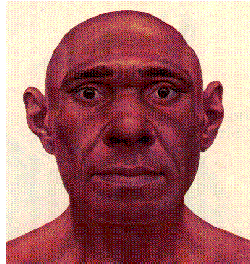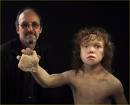Neanderthal's Fossil Yields Bits Of Elusive DNA

A tiny fossil fragment from a Neanderthal man who lived and died 38,000 years ago has yielded the first snippets ever discovered of the extinct creature's crucial genes -- and they show that the species was strikingly identical to our own human ancestors.
The achievement marks the start of a major effort to learn whether those heavy-browed, thickset, primitive Neanderthals succumbed to overwhelming waves of more gracefully built and sophisticated modern people or whether human and Neanderthal genes merged through generations of interbreeding.
That controversy has long been vigorously debated among researchers, but the scientists who have analyzed the first samples of the man's DNA say they see no clear evidence so far that the two did in fact interbreed.
They hope to complete a true Neanderthal Genome Project -- one similar to the historic, now-completed Human Genome Project -- within two years. Recovering all the genes and seeing where and how they differ from modern humans is vital to understanding the history of human evolution.
"We're clearly at the dawn of the era of Neanderthal genomics," said geneticist Edward Rubin, who led one of two teams of scientists that are reporting on their DNA discoveries this week. "It's like cracking the code of hieroglyphics to learn about the everyday life of the ancient Egyptians."
To find their elusive genetic material, the two teams of scientists teased the first "base pairs" -- the chemical building blocks of DNA -- from the fossilized thighbone of a Neanderthal man who had lived in a cave named Vindija near Vilna in what is now Croatia.
Rubin, director of the Department of Energy's Joint Genome Institute in Walnut Creek, and his team are publishing their results in the American journal Science on Friday. The other group, headed by Svante Paabo of the Max Planck Institute for Evolutionary Biology in Leipzig, Germany, is reporting its findings Thursday in the British journal Nature.
Both Rubin and Paabo, who collaborated on much of the work, also described their results in a joint teleconference with reporters Wednesday.
The Rubin team, including postdoctoral fellow James Noonan and other scientists from the Lawrence Berkeley National Laboratory, determined the sequence of more than 65,000 base pairs of DNA from the Neanderthal femur, eliminated all the contaminating genetic material from countless microbes that had invaded the rotted bone, and analyzed the remaining material closely. The group also used bacteria to clone the Neanderthal DNA and increase the yield of useful material for analysis.
Paabo's team, whose co-leader was Richard Green of the Planck Institute, analyzed a million base pairs of DNA from the same fossil, using a new high-speed sequencing technology developed by 454 Life Sciences, a Connecticut biotech firm that Rubin's group also used for part of its work.
The fossil bone both groups shared yielded only a tiny bit of useful material -- no more than 200 milligrams, Paabo said -- less than the weight of a melon seed. But that was enough to tease out the DNA, analyze the base pairs and compare their sequences to chimpanzee and human DNA. Then they created a "molecular clock" based on genetic mutation rates that gave the teams their timetables for the history of the two species.
Deciphering all the Neanderthal genes, Rubin said, "will act as a DNA time machine," revealing their nature, their evolution and their relation to the modern humans who supplanted them.
The Rubin team has already recovered DNA from a 40,000-year-old fossil cave bear that lived at the same time as the Neanderthals, and that discovery, reported last year, encouraged his colleagues to move on to the Neanderthal mission, he said.
Even the meager trove of Neanderthal DNA that the two teams recovered from the single fossil bone shows that the genes of Neanderthals and humans are more than 99.5 percent identical, Rubin said.
According to their DNA analysis, the last common ancestor of Neanderthals and humans lived about 700,000 years ago, and the ancestral populations of humans and Neanderthals diverged and split into distinct species about 370,000 years ago -- well before the evolution of anatomically modern humans and a long, long time before the fossil man whose DNA Rubin and Paabo analyzed.

Paabo's group calculated a somewhat different time for the split between the two groups of people: The separation, he reported, probably occurred on average about 516,000 years ago. But the difference between the two divergent times was well within the "error bars" of their calculations, the two team leaders agreed.
The DNA material in the tiny sample of fossil bone came mostly from the Neanderthal's Y chromosome, a sure indication that their creature was a male, they said.
Despite both teams' insistence that they see no clear evidence of interbreeding in the Neanderthal or human DNA, one noted anthropologist who was not part of the work disagreed.

Milford Wolpoff of the University of Michigan called the two reports "the most exciting advance in understanding the Neanderthal world." But he pointed to one suggestion in the Paabo report that said "gene flow may have occurred predominantly from modern human males into Neanderthals."
In a burst of enthusiasm, Wolpoff said, "There is no other explanation for this kind of gene flow, and it's unequivocal evidence for interbreeding."



1 Comments:
there are some who believe neanderhtal man was a homo sapien who may have suffered from a form of rickets
Post a Comment
<< Home